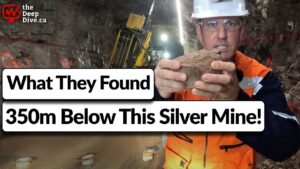TORONTO, ONTARIO, Feb 20, 2014 (Marketwired via COMTEX) — Mammoth Resources Corp. CA:MTH -14.29% is pleased to announce that it has posted a technical report summarizing historical and recent work performed on its Tenoriba Property, located in the prolific Sierra Madre precious metal belt in south western Chihuahua state, Mexico (refer to the company’s web sitewww.mammothresources.ca , for a detailed location map). The technical report provides a review of all known historical work performed on the property and all work performed by Mammoth Resources until the end of 2013. The report recommends drilling geophysical targets and continuing metallurgical testing of precious metal enriched cyanide leachable material on the property.
Thomas Atkins, President and CEO of Mammoth Resources commented on the report, stating: “It’s clear to us, as we compile all of the information that has gone into this report, that we have a large 15 square kilometre area of enriched gold and silver mineralization occurring at Tenoriba. The combination of the precious metals, with various geochemical relationships with gold and silver mineralization from over 600 samples analyzed by Mammoth and at least an equal amount by its predecessors, that we are in a relatively shallow elevation, high sulphidation, epithermal system. The implications of the shallow system are that we believe there’s excellent potential to intersect intriguingly precious metal mineralized rocks at depth similar to what was previously intersected in drilling performed in 2008. The recently completed geophysics program, although the results are not covered in this report, has provided some terrific drill targets. We’re currently defining these drill locations and expect to report on these targets and details of a drill program, shortly.”
Summary of the Findings of the Technical Report
A field work program was conducted on the Tenoriba property during 2012 and 2013 by Recursos Mineros Mamut S.A. de C.V. (100% owned Mexican subsidiary company of Mammoth Resources Corporation). The results of this work are combined with historical data generated by Masuparia Gold Corp., from work performed in 2007 and 2008, including diamond drill results from 15 drill holes drilled in 2008. Mamut geologists began a field mapping and sampling campaign in October 2012. As at the date of writing of the report a total of 628 rock surface samples, 10 bulk leachable gold (BLEG) type stream sediment samples and 100 Terraspec samples have been collected and analysed by ASL CHEMEX LAB with sample preparation performed in Chihuahua, Chihuahua state Mexico and the pulps assayed in Vancouver, Canada. Specific details of the analysis and QA/QC measures taken in such analysis, are provided in the report. The report was authored by Richard Simpson, Mammoth’s Vice President Exploration and the company’s Qualified Person. Except for the lack of independence from Mammoth, which Mr. Simpson holds as a result of his position with the company, the company believes the technical report would conform to NI-43-101 quality standards.
Field work during the period covered by the report identified property geology dominated by the Late Cretaceous/Tertiary aged felsic volcanic rocks of the Sierra Madre Occidental, dominantly underlain by felsic volcanic rocks of Tertiary age, consisting of felsic volcaniclastic rocks (tuffs, Ignimbrites, volcanic breccias), which are intruded by granodioritic to dioritic composition intrusive bodies. Small felsic and intermediary dykes have also been noticed but generally their locations have not been mapped in detail.
Specific target areas identified to date within this large 15 square kilometre precious metal (gold and silver) mineralized area include, from west to east: Cerro Colorado, El Moreno, Masuparia area and Los Carneritos. These target areas can be described mainly as shallow high sulphidation epithermal targets hosted by a highly altered (argillic and silica alteration) upper volcanic sequence. The mineralization is closely associated to the silica alteration, including local vuggy silica and clay minerals associated with mineralization, including: dickite, kaolinite, illite and halloysite. Only minor sulphide has been identified on surface. East-northeast to almost east-west, plus northeast, northwest and almost north striking and generally steeply dipping normal faults are the main interpreted ore controls. On the periphery of these priority areas and generally beyond the 15 square kilometre area of enriched precious metal mineralization, an additional, lesser explored targets targets include: Arroyo Verde, La Verde, Rincon Colorado and the area of La Quemada where polymetallic enriched viens are noted.
Although company geologists have divided the target areas into separate targets for ease of identification, there is nothing evidenced on surface, in the stratigraphy or lithologies in which these targets exist, that would suggest that these target areas are not connected at depth, having only been separated either by faulting or simply a lack of outcrop evidencing their relationship one to the other.
In addition to elevated and ubiquitous occurrences of gold and silver there are a number of compelling characteristics to the rocks sampled that are commonly associated with high sulphidation epithermal precious metal systems. These characteristics occur in strong association with stratigraphic controls to mineralization. These associations are the most compelling evidence that the Tenoriba targets are part of a shallow elevation, high sulphidation epithermal mineralizing system. The shallow elevation of the system observed on surface implies that feeder systems, responsible for precious metal enrichment to this shallow system mapped and sampled on surface, could occur at depth.
Characteristics observed from the surface mapping and sampling that are common in high sulphidation systems, include:
-- An overall lack of copper and other base metals (zinc and lead),
indicating a high elevation system;
-- Samples that are enriched in gold and silver frequently assay elevated
levels of mercury, antinomy and arsenic;
-- The silver to gold ratio is low, tending towards approximately 12 to 16;
and
-- Where samples assay enriched gold and silver values (greater than 1.0
g/t gold equivalent) these samples are associated with high tellurium
and high tellurium over selenium ratios (Masuparia compiled rock chip
assay results which show this relationship).
In addition to these geochemical relationships observed at Tenoriba and common in high sulphidation epithermal systems, precious metal mineralization in the 15 square kilometre area is closely associated with silica alteration and ubiquitous occurrences of vuggy silica texture. Clay minerals, including dickite, kaolinite, illite and halloysite are also strongly associated ith precious metal mineralization in these areas, offering further support of the high sulphidation categorization of precious metal mineralization at Tenoriba.
The potential within the 15 square kilometre area of elevated and ubiquitous gold and silver to host a large precious metal deposit is compelling given the abundance of precious metals sampled within this large surface area.
Beyond mapping the geology and structures on the property and sampling many potential occurrences of precious metals, geologists also investigated some of the metallurgical characteristics of these rocks. The objective in studying the metallurgical characteristics was to gain some knowledge of the potential processes available for the extraction of these precious metals should the mineral resource be shown to contain a sufficient amount and concentration of precious metal to warrant their recovery and to help guide stages of future exploration.
Given the abundance of gold on the surface, it is logical to consider that it may be possible to mine the precious metals via an open pit which in combination with heap leach precious metal extraction and recovery, could have the potential for a low capital and operating cost type operation. Understanding this potential early in the exploration process could have implications for how to most efficiently explore the property and possibly develop precious metal resources (drill hole spacing, grade of potentially significant drill hole intersections).
Preliminary petrographic work on some select drill core intervals demonstrated the presence of free gold on the periphery of sulphide grains and within fractures in these sulphide grains, illustrating the ‘free’ nature of gold in these occurrences. The presence of free gold that is amenable to cyanide leaching was further illustrated as Mamut geologists conducted an in-depth sampling of various core intervals at a variety of depths and grades, plus various samples collected from surface. Agitated cyanide leach bottle roll tests of these samples resulted in high, often rapid (often in less than 12 hours), recoveries of precious metals (often greater than 90 percent recovery) to vertical depths of as much as 60 metres, with the occasional, high recoveries (generally below 70 percent) at greater depths and requiring greater time (up to 72 hours).
These results bode well for precious metal recovery in a cyanide leach-type setting such as a heap leach operation.
Recommendations for future work, include:
-- Additional mapping of the four priority areas; Cerro Colorado, El
Moreno, Masuparia area and Los Carneritos with particular attention on
the structural controls in these areas with the objective of better
understanding these structural controls and there possible association
to precious metal mineralization. The cost of such work is estimated at
approximately CDN$25,000.
-- Perform a ground induced polarized (IP) and ground magnetic (mag) survey
over the four priority target areas with the objective that the survey
may assist in identifying structures and the possible roots (feeder
systems) to enriched precious metal mineralization sampled on surface.
In addition, the survey may assist in identifying extensions to
Masuparia's precious metal enriched drill intercepts. Approximately 100
linear kilometres of geophysical lines spaced 100 metres apart, one from
the other would be needed to cover the four priority target areas, plus
the Arroyo Verde target. It is recommended that the survey be performed
in two phases in order to test the application of geophysics as a tool
to determine precious metal feeders and structures at depth. Phase one
areas should be prioritized for this potential. The first phase
(approximately 32 linear kilometres) being programmed will cover the
core of Los Carneritos, the Masuparia area and portions of the El Moreno
target areas. As of the writing of this report, the first phase of this
survey has been performed by Geofisica TMC of Mazatlan, Mexico. The cost
of the 32 kilometre line kilometres of ground IP and mag, including
mobilization and de-mobilization plus field support was approximately
CDN$100,000. The company intends to post the results of this survey,
complete results of which were not available as of the timing of the
writing of this report, on its website once available.
-- At the Los Carneritos target area, five large outcrops (measuring as
large as 80 square metres) highly silicified with patchy vuggy silica
have returned values above 1.0 g/t gold up to 6.41 g/t gold and 34.0 g/t
silver over 1.0 metre channel sample (sample number 330406). Further
detailed mapping and sampling along a grid on 5 metres by 5 metres
sample spacing is recommended to be performed. If sample results warrant
(if average values over an area sufficient to meet material supply
requirements), it is recommended that a composite of these samples be
sent for bottle roll tests to determine leach time, recoveries, cyanide
consumption and acidity among other measures. Based on these results, it
is recommended to perform cyanide leach column tests on this material to
establish the most attractive conditions for heap leaching. Based on
these results and the availability of material from these sample areas,
it is recommended that consideration be given to establishing a pilot
plant heap leach operation to better test the characteristics of heap
leaching recognizing the cost to revenue potential of such an exercise.
The first phase of this recommended program began in November 2013 and
was completed one month later. At present, the company is awaiting assay
results, not all of which were available as of the writing of this
report. The cost of the field work and sample analysis for the first
phase of this recommended program was approximately $10,000. The cost of
the second phase, bottle roll portion of this work is estimated at
CDN$15,000. The cost of the column test phase of this recommendation is
estimated at approximately CDN$15,000.
-- It is recommended that additional road access, especially towards Los
Carneritos and Cerro Colorado target areas be constructed. This road
access, in addition to simply facilitating access for people and
equipment may also provide some additional cuts for exposure of rocks in
the area for enhanced mapping. The cost of such work is estimated at
approximately CDN$25,000 - $30,000.
-- It is recommended, based on the results of the geophysics survey, to
conduct a 2,000 to 3,000 metre first phase reverse circulation (RC) or
diamond drill campaign to test targets indicated by this survey in
conjunction with targets identified by the surface work described in
this report. Prior to initiating any road building and drilling
activities signed agreements with the local ejidos will be required as
will various environmental permits. Mamut geologists have begun
consultation with the representatives of the ejiodos in the area and are
confident of the ability to attain the cooperation of these ejidos to
conduct this work. Furthermore, the company will require approval from
the state government Secretaria del Medio Ambiente y Recursos Naturales
(SEMARNAT), the Secretariat of Environment and Natural Resources. As of
the writing of this report, consultations had begun with various drill
contractors regarding quoting on a program comprising approximately 15
drill holes totalling 2,500 metres, plus, or minus 500 metres.
Consultations have also begun with various contractors to assist in the
writing of the permit application to be presented to the Secretaria del
Medio Ambiente y Recursos Naturales (SEMARNAT), the Secretariat of
Environment and Natural Resources for approval to drill. The drafting
and submission of this report is estimated to cost CDN$5,000 to 8,000. A
2,000 to 3,000 metre RC program, including mobilization and de-
mobilization, plus all field support and sample analysis is estimated at
this time to cost approximately CDN$260,000 to $300,000.
Of the costs estimated to perform the recommendations of this report, totalling: CDN$455,000 to $503,000, CDN$110,000 has already been spent on the geophysics survey and the first phase of the Carneritos outcrop/pilot heap leach sampling. A balance of $345,000 to $393,000 would be required to be spent to complete the recommendations of this report. This work, could be performed within a six month time frame. Ideally the company would like to perform this work prior to the commencement of the rainy season in the Sierra Madre which tends to become problematic due to the periods and quantity of rain in mid to late July.
Qualified Person / Quality Controls:
Richard Simpson, P.Geo., Vice-President Exploration for Mammoth Resources Corp. is Mammoth’s Qualified Person, according to National Instrument 43-101, for the Tenoriba property and is the author of this technical report.
About Mammoth Resources:
Mammoth Resources CA:MTH -14.29% is a mineral exploration company focused on acquiring and defining precious metal resources in Mexico and other attractive mining friendly jurisdictions in the Americas. The Company has an option to acquire 100% in the Tenoriba Property located in the Sierra Madre Precious Metal Belt in southwestern Chihuahua State, Mexico. The company continues to seek other option agreements in the Americas on other properties it deems to host above average potential for economic concentrations of precious metals mineralization.
To find out more about Mammoth Resources and to sign up to receive future press releases, please visit the company’s website at www.mammothresources.ca .
Neither the TSX Venture Exchange nor its Regulation Services Provider (as that term is defined in the policies of the TSX Venture Exchange) accepts responsibility for the adequacy or accuracy of this release.
Forward Looking Information: This news release may contain or refer to forward-looking information. All information other than statements of historical fact that address activities, events or developments that the Company believes, expects or anticipates will or may occur in the future are forward-looking statements; examples include the listing of its shares on a stock exchange and establishing mineral resources. These forward-looking statements are subject to a variety of risks and uncertainties beyond the Company’s ability to control or predict that may cause actual events or results to differ materially from those discussed in such forward-looking statements. Any forward-looking statement speaks only as of the date on which it is made and, except as may be required by applicable securities laws, the Company disclaims any intent or obligation to update any forward-looking statement, whether as a result of new information, future events or results or otherwise. Although the Company believes that the assumptions inherent in the forward-looking statements are reasonable, forward-looking statements are not guarantees of future performance and, accordingly, undue reliance should not be placed on these forward-looking statements due to the inherent uncertainty therein.
Contacts:
Mammoth Resources Corp.
Thomas Atkins
President & CEO
tom@mammothresources.ca
www.mammothresources.ca
SOURCE: Mammoth Resources Corp

















